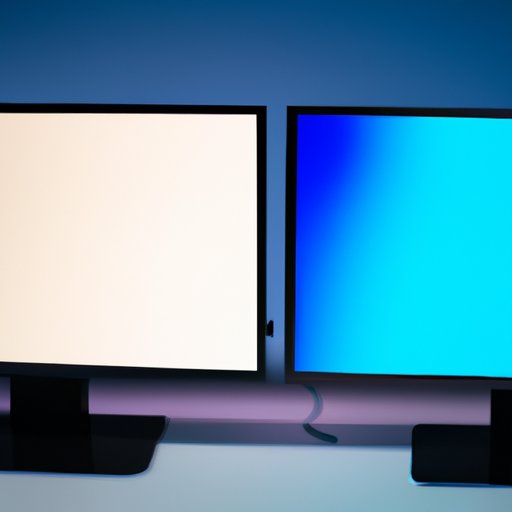
I. Introduction
Having a dual monitor setup can greatly improve your productivity, whether you’re working on a project or gaming. In this article, we will be discussing the step-by-step process of how to connect two monitors to your PC or laptop, multi-display setups, maximizing screen real estate, tips and tricks for smooth setup, connecting multiple monitors for enhanced work efficiency, and setting up dual monitors for beginners.
II. Step-by-Step Guide to Connecting 2 Monitors to a PC or Laptop
Before setting up your dual monitor, make sure to have the necessary hardware components such as a compatible computer or laptop, video card, monitors, and cables. Follow these steps to connect two monitors to your PC or laptop:
- Connect the first monitor to your computer or laptop using the VGA, DVI, HDMI, or DisplayPort cable.
- Connect the second monitor to your computer or laptop using the same type of cable as the first monitor.
- Select the appropriate input for each monitor from the display settings on your computer.
- Configure the display settings to extend or duplicate your screen onto the second monitor as desired.
III. Multi-Display Setups: How to Connect Dual Monitors on Windows or Mac
To connect dual monitors on Windows OS, right-click on your desktop and select Display Settings, then click on “Extend these displays” and select the orientation of the screens. For Mac OS, go to System Preferences, click on Displays, and select “Arrangement” to configure your multiple displays.
IV. Maximizing Screen Real Estate: How to Set Up Dual Monitors for Gaming or Work
Setting up dual monitors can be beneficial for both gaming and work. To optimize your dual monitor setup for gaming, make sure to configure your settings for maximum performance and choose monitors with low input lag. For work, it can help to have different applications open on different screens to increase productivity. You can also use software tools like DisplayFusion or Ultramon for better multitasking.
V. The Ultimate Guide to Connecting Two Monitors: Tips and Tricks for Smooth Setup
Common issues that people encounter when setting up dual monitors include resolution and scaling problems, video card compatibility, and mismatched cables. Troubleshooting tips include updating your drivers, checking the compatibility of your video card, and ensuring that all cables are properly connected. Best practices for setting up dual monitors include choosing monitors with the same resolution and refresh rate, calibrating your monitors, and positioning them at an optimal distance from your face.
VI. Double the Productivity: How to Connect Multiple Monitors for Enhanced Work Efficiency
Connecting multiple monitors for work can increase your productivity by allowing for multiple applications or programs to be open simultaneously. To set up multiple monitors, make sure that your graphics card can support multiple displays, connect each monitor to its own video output, and configure the display settings to extend your screen onto both screens. You can also use hardware like a dock or splitter to connect multiple monitors to your device.
VII. No More Screen Juggling: Discover How to Connect Dual Monitors to Your Desktop
Connecting dual monitors to your desktop follows a similar procedure as connecting it to your laptop or PC. Make sure to have the necessary video card and monitors, connect the cables, and configure the display settings. For an optimal dual monitor setup on your desktop, make sure to choose high-quality monitors with adjustable stands, position your screens for the best viewing angle, and adjust the brightness levels according to your preferences.
VIII. Dual Monitors Made Easy: A Beginner’s Guide to Setting Up Multiple Screens
Using dual monitors can be intimidating for beginners, but it doesn’t have to be. The first step is to understand the benefits of using dual monitors, such as increased screen real estate and productivity. Follow the step-by-step guide outlined in section II, making sure to have all the necessary hardware components. Common mistakes to avoid when setting up dual monitors include choosing monitors with unmatched resolutions or refresh rates, using cables that are not compatible with your video card, and neglecting to configure the display settings for your dual monitor setup.
IX. Conclusion
This comprehensive guide has covered everything you need to know about how to connect two monitors for an enhanced gaming or work experience. Whether you’re a beginner or a seasoned user, there are tips and tricks for everyone to improve their dual monitor setup.




